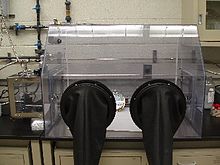Glove box

A common rigid-plastic glovebox, seen with gloves turned inside-out
|
|
| Uses | Inert atmosphere work Hazardous materials work |
|---|---|
| Related items |
Desiccator Schlenk line |
A glovebox (or glove box) is a sealed container that is designed to allow one to manipulate objects where a separate atmosphere is desired. Built into the sides of the glovebox are gloves arranged in such a way that the user can place their hands into the gloves and perform tasks inside the box without breaking containment. Part or all of the box is usually transparent to allow the user to see what is being manipulated. Two types of gloveboxes exist: one allows a person to work with hazardous substances, such as radioactive materials or infectious disease agents; the other allows manipulation of substances that must be contained within a very high purity inert atmosphere, such as argon or nitrogen. It is also possible to use a glovebox for manipulation of items in a vacuum chamber.
The gas in a glovebox is pumped through a series of treatment devices which remove solvents, water and oxygen from the gas. Heated copper metal (or some other finely divided metal) is commonly used to remove oxygen, this oxygen removing column is normally regenerated by passing a hydrogen/nitrogen mixture through it while it is heated: the water formed is passed out of the box with the excess hydrogen and nitrogen. It is common to use molecular sieves to remove water by absorbing it in the molecular sieves' pores. Such a box is often used by organometallic chemists to transfer dry solids from one container to another container.
An alternative to using a glovebox for air sensitive work is to employ Schlenk methods using a Schlenk line. One disadvantage of working in a glovebox is that organic solvents will attack the plastic seals. As a result, the box will start to leak and water and oxygen can then enter the box. Another disadvantage of a glovebox is that oxygen and water can diffuse through the plastic gloves.
Inert atmosphere gloveboxes are typically kept at a higher pressure than the surrounding air, so that any microscopic leaks are mostly leaking inert gas out of the box instead of letting air in.
...
Wikipedia
